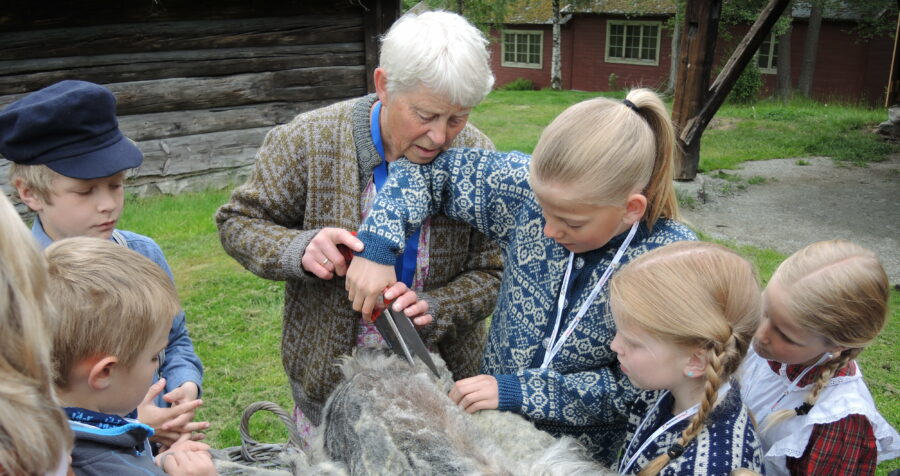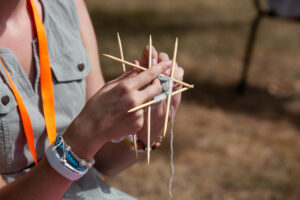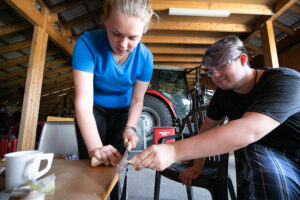Folk art and craft groups for youth

Background
Craft education is under pressure. With today’s school system geared towards theoretical knowledge and digital learning, many children and young people lack the opportunity to play with materials and learn basic craft techniques. At the same time, there is an urgent need to safeguard traditional craft skills for the future. The slow, analogue nature of handicrafts is easily devalued in a society that sets speed, efficiency, and technological advancements at the forefront.
In answer to these challenges the Norwegian Folk Art and Craft Association (Norges Husflidslag) has over the past decade worked specifically to promote craft opportunities for children and young people. With the aim of encouraging learning and recruiting future practitioners, folk art and craft groups for young people (Ung Husflid-grupper) have been established across the country.
Objectives
The objective is simple: to connect youth with traditional crafts. The goal is both to enrich young people’s education and personal experience through craft, and at the same time to keep these traditional techniques and skills alive and active.
Indeed, working with children and young people in this way, is in line with UN’s Sustainable Development Goal no. 4: “Ensure inclusive and equitable quality education and promote lifelong learning opportunities for all.”
The craft groups are for young people between the ages of 6 and 26, and host activities ranging from summer craft camps, regular craft meet-ups, workshops, and activities at festivals and local fairs. Here, children and young people are given the opportunity to practice different craft techniques, play with colours and textures, learn about materials and how to use basic hand tools. Weaving, knitting, wood working, carpentry, embroidery and sewing are all examples of techniques practiced.
What began tentatively as a three-year project in 2008 has since evolved into an important pilar of the Norwegian Folk Art and Craft Association’s work. More than a hundred local craft groups for youth are now established across the country. They are run and organised through the local member groups of the Norwegian Folk Art and Craft Association. In this way the groups are community driven and provide local youth with a sense of connection to their district and region.
In addition, over two hundred fun and easy do-it-yourself projects geared towards youth are available online as an open-access archive. These projects include knitting, sewing, weaving, dyeing, wood work, paper craft and more. With easy-to-follow instructions and images, crafting is made fun and widely accessible.
How it was done
Not only do the craft groups for youth provide children and young people with the opportunity to practice, learn and play with craft techniques, but it is also an important measure in safeguarding traditional handicrafts for the future. Few things can be learned through theoretical knowledge alone. Right from the very beginning, we learn by doing.
We observe, copy and practice. Imagine the toddler´s first unbalanced steps. Imagine the beginner wood worker as she grips the knife and feels the tug of the blade against wood. Through trial and error, we build experience. We get a feel for the materials, tools and techniques required to solve the problem at hand.

Learning by doing. Knitting.
Photo: Hanne Kjersti S. Iversen
Torunn Elise Kveen (2019), from the Association for Studies of Culture and Traditions, explains this as “action-transmitted knowledge”:
“Action-transmitted knowledge is the term we use to describe how the knowledge of craft is based in action and practice. It also describes how a craft is carried on. It is an international language we can practice together: a language that bridges different cultures.”
Precisely by practicing traditional handicraft techniques and learning from skilled practitioners, generations worth of tacit knowledge and practical skills are kept alive.
Learning traditional handicrafts is slow work. It requires patience, concentration, and not least, practice. Working with your hands also sets a rhythm and pace that can feel peaceful and keeps you grounded. In this way, practicing traditional crafts can provide children and young people with an antidote to the fast-paced world of instant entertainment, information overload and social media updates. There are mental health benefits from slowing down and focusing on the tactile experience of crafting. Creating a tangible product with your own two hands boosts confidence and self-worth.

Learning by doing.
Photo: Hanne Kjersti S Iversen.
In addition, working with traditional handicrafts raises awareness of sustainability issues. How are the objects we use daily made? What materials are they made of? Can we repair them if they break or tear? Can we make our own?
Thus, providing children and young people with the opportunity to practice crafts is in fact also in tune with the UN’s Sustainable Development Goals no. 3: “Ensure healthy lives and promote well-being for all at all ages” and no. 12: “Ensure sustainable consumption and production patterns”.
The Nordic Craft Camp for Youth
There is also an important social aspect of learning together in a shared space. Traditional handicrafts transcend borders with a common cultural heritage.
One example of how the Norwegian Folk Art and Craft Association has worked specifically with young people and cross-cultural collaboration, is the Nordic Craft Camp for Youth. Many of the Nordic and European countries have similar handicraft traditions, each with their own unique local variations. Crafting itself is a common language that inspires connection across borders.
The Nordic Craft Camp for Youth was held in 2018, gathering young people between the ages of 16 and 22, from Norway, Sweden, Finland, Iceland and Estonia. Over the course of four days, young instructors from the Nordic and Baltic countries held workshops ranging from Icelandic knitting to wood working and sewing. Creating a space where young people can meet, form friendships, and share their common interests in making, is important to maintaining and renewing craft traditions. It also encourages cross-cultural connection and collaboration.
The camp was initiated and organised by the Norwegian Folk Art and Craft Association, in close collaboration with the other member organizations of the Nordic Folk Art and Craft Federation. The camp was a success and is now continued as Young Craft, a camp for youth held every other year within the Nordic region.
Author of article: Louisa Gjersø Bond
Communications Advisor
Reference:
Kveen, T. E. (2019). Action-transmitted knowledge, 2019 World Forum for Intangible Cultural Heritage. Korea 10. – 12. October 2019. Available at: https://kulturogtradisjon.s3.amazonaws.com/media/files/000/000/531/original/Artikkel_Korea_nett.pdf?1571818335 (Accessed: 19. February 2021)
Key factors
1. Community- driven
One of the key factors of success with the Norwegian Folk Art and Craft Association’s work with children and young people, is the community-driven nature of the work. Each of the craft groups for youth are organised within the organization’s established local member groups. This is volunteer based work that encourages connection and community building.
2. Cooperation and organization
The local craft groups for youth are well-supported from the top down within the Norwegian Folk Art and Craft Association. A range of books and pamphlets, as well as diplomas, badges, tote bags and other merchandise, have been made over the years to encourage and support various craft activities. The popular do-it-yourself projects online also spur fresh inspiration and ideas. These give both young people themselves and adults working with children an introduction into the world of traditional handicrafts. Moreover, it allows the Norwegian Folk Art and Craft Association to reach a broader audience beyond the members of the local craft groups for youth themselves.
3. Active practitioners
The Norwegian Folk Art and Craft Association works to promote traditional crafts and ensure they are kept alive and flourishing through continued practice. While providing adult learning opportunities has long been a major part of the organization’s work, focusing specifically on youth is now recognised as being equally important.
Traditional crafts embody intangible cultural heritage. They are practices finetuned through generations of craftsmen. The tacit knowledge, skills and techniques involved in mastering traditional crafts, are kept alive and maintained only as long as there are practitioners who master them.
Creating something with your hands and simple hand-tools gives deep satisfaction. Introducing young people to traditional handicrafts has many positive benefits, from increased well-being, greater awareness of sustainability issues, to cross-cultural connection. Furthermore, engaging with youth is essential in order to safeguard traditional handicrafts for the future.

